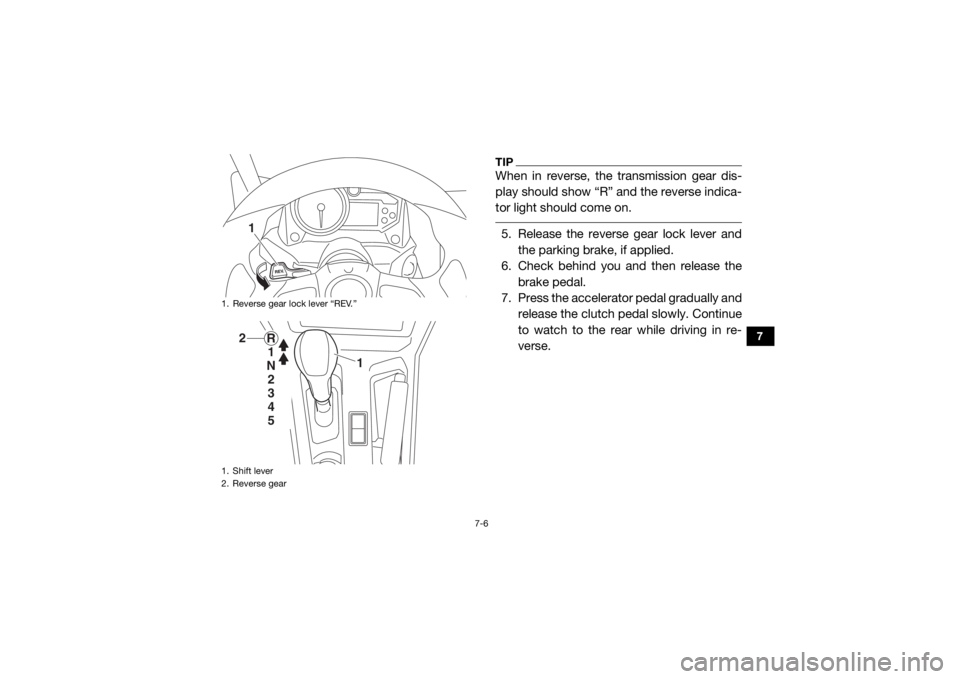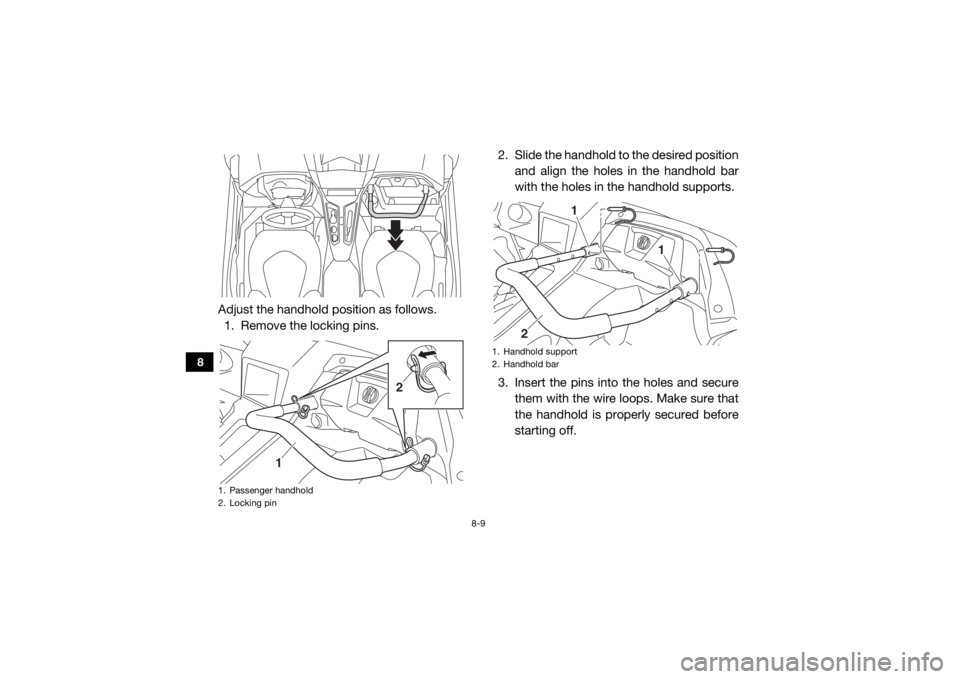lock YAMAHA YXZ1000R 2020 Owner's Manual
[x] Cancel search | Manufacturer: YAMAHA, Model Year: 2020, Model line: YXZ1000R, Model: YAMAHA YXZ1000R 2020Pages: 198, PDF Size: 8.22 MB
Page 86 of 198

7-5
7
can cause the tires to lose traction, reducing
control and increasing the possibility of an ac-
cident.
WARNING
EWB00712Make sure the engine has sufficiently
slowed before shifting to a lower gear. En-
gaging a lower gear when the engine
speed is too high could make the wheels
stop rotating and lose traction. This could
cause loss of control, an accident and inju-
ry. It could also cause engine or drivetrain
damage. Recommended shift points
The recommended shift points during accel-
eration and deceleration are shown in the ta-
ble below.To drive in reverse
WARNING
EWB03300Before you shift into reverse, make sure
there are no obstacles or people behind
you. When it is safe to proceed, go slowly.
Hitting an obstacle or
person could result
in serious inju ry or death. 1. Stop the vehicle and continue to apply
the brake pedal.
2. Check behind you.
3. Press the clutch pedal, and pull the re- verse gear lock lever.
4. Shift the transmission into reverse.Shift up points: 1st → 2nd: 19 km/h (12 mi/h)
2nd → 3rd: 33 km/h (21 mi/h)
3rd → 4th: 44 km/h (27 mi/h)
4th → 5th: 53 km/h (33 mi/h)
Shift down points: 5th → 4th: 30 km/h (19 mi/h)
4th → 3rd: 17 km/h (11 mi/h)
UB5J7BE0.book Page 5 Tuesday, June 18, 2019 10:07 AM
Page 87 of 198

7-6
7
TIPWhen in reverse, the transmission gear dis-
play should show “R” and the reverse indica-
tor light should come on. 5. Release the reverse gear lock lever and the parking brake, if applied.
6. Check behind you and then release the brake pedal.
7. Press the accelerator pedal gradually and
release the clutch pedal slowly. Continue
to watch to the rear while driving in re-
verse.
1. Reverse gear lock lever “REV.”
1. Shift lever
2. Reverse gear
1
1
2
R 1
N 2
3
4
5
UB5J7BE0.book Page 6 Tuesday, June 18, 2019 10:07 AM
Page 88 of 198

7-7
7
EBU35061Selecting the drive modeThe vehicle handles differently in each of the drive modes: “2WD”, “4WD” and “DIFF LOCK”. For
example, the vehicle requires more effort to turn in “DIFF LOCK” than in “2WD”. Always stop the
vehicle before changing the position of th e On-Command drive knob. The drive mode icon
changes according to the selected drive mode. The drive mode icon and the “DIFF LOCK” indi-
cator light come on as follows:
Knob position Indication Drive mode
(none)
“2WD” (two-wheel drive): Drive power is supplied to the rear
wheels only.
“4WD” (four-wheel drive): Drive power is supplied to the
front and rear wheels.
“DIFF LOCK” (four-wheel drive with the differential gear
locked): Drive power is supplied to the front and rear wheels
and the differential gear is locked.
Unlike in four-wheel drive, all wheels turn at the same
speed.
UB5J7BE0.book Page 7 Tuesday, June 18, 2019 10:07 AM
Page 89 of 198

7-8
7
TIPWhen the knob is set to “DIFF LOCK” or “4WD ”, the drive mode icon and the indicator light
will flash until the differential gear is completely locked or unlocked.
Turning the steering wheel back and forth will help the differential gear lock to engage or dis-
engage.
To protect the drivetrain from damage, vehicle speed is limited until the differential gear lock
has properly transitioned. UB5J7BE0.book Page 8 Tuesday, June 18, 2019 10:07 AM
Page 100 of 198

8-9
8
Adjust the handhold position as follows.1. Remove the locking pins. 2. Slide the handhold to
the desired position
and align the holes in the handhold bar
with the holes in the handhold supports.
3. Insert the pins into the holes and secure them with the wire loops. Make sure that
the handhold is properly secured before
starting off.1. Passenger handhold
2. Locking pin
1
2
1. Handhold support
2. Handhold bar
2
1
1
UB5J7BE0.book Page 9 Tuesday, June 18, 2019 10:07 AM
Page 104 of 198

8-13
8
Practice for new Yamaha YXZ1000R users
Become familiar with the performance char-
acteristics of the vehicle in a large, flat area
that is free of obstacles and other vehicles.
Practice controlling the accelerator pedal,
clutch, brakes, steering, and shift lever. Drive
at slow speeds with gradual acceleration and
smooth turns. Practice applying the accelera-
tor pedal smoothly. Practice slowing down
before turning. Practice maintaining a steady
amount of throttle (accelerator pedal position)
through the turn. Avoid higher speeds until
you are thoroughly familiar with the operation
and handling of the vehicle. Remember, driv-
ing aggressively or making abrupt maneuvers
even on flat, open areas can cause side roll-
overs.Become familiar with the way the vehicle han-
dles in the various drive modes. Start off with
two-wheel drive “2WD”, then four-wheel drive
“4WD”, and finally four-wheel drive with the
differential locked “DIFF LOCK”. Steering
may take more effort in four-wheel drive with
the differential locked “DIFF LOCK”. Also
practice driving in reverse.
TIPTake the time to learn basic operation of the
vehicle before driving at higher speeds or at-
tempting more difficult maneuvers.
UB5J7BE0.book Page 13 Tuesday, June 18, 2019 10:07 AM
Page 107 of 198

8-16
8
Parking on a slope
The parking brake is located on the rear drive
shaft. When the drivetrain is in “2WD” mode,
only the rear wheels will be locked. Therefore,
switch the drive mode to “DIFF LOCK” before
stopping the engine to lock all four wheels
when parking. In addition to the parking
brake, leave the transmission in gear to help
prevent the vehicle from rolling.
If you park on a hill that is too steep, the vehi-
cle may roll out of control. Never park on hills
that are so steep you cannot walk up them
easily. If you must park on an incline, follow
these instructions:1. First, bring the vehicle to a stop and con- tinue to apply the brake pedal.
2. Switch the drive mode to “DIFF LOCK”
and shift into first gear when parking up-
hill, or reverse gear when parking down-
hill.
TIPYou may need to turn the steering wheel left
and right or release the clutch slightly to help
the differential lock into place. 3. Stop the engine (turn the key to “ ”[off]).
4. With the brake pedal still being applied, set the parking brake.
5. Finally, get out of the vehicle and block
the front and rear wheels with rocks or
other objects.
Loading
Be aware that vehicle load includes the total
combined weight of the operator, passenger,
any installed accessories, and any luggage or
cargo brought on board or stored in the cargo
bed. Make sure that the gross vehicle weight
(vehicle load plus weight of the vehicle itself)
never exceeds 1065 kg (2348 lb).
UB5J7BE0.book Page 16 Tuesday, June 18, 2019 10:07 AM
Page 109 of 198

8-18
8
sense and remember that some hills are too
steep for you to climb or descend. Use proper
driving techniques to avoid rearward, for-
ward, or sideways rollovers on hills and
slopes.
Drive straight up and down inclines, not
across them. If crossing a hill is unavoidable,
drive slowly. Turn downhill immediately if you
feel the vehicle may tip.
If you think or feel the vehicle may tip or
roll:
Brace yourself by pressing your feet firmly
on the floorboard and keep a firm grip on
the steering wheel or passenger handhold.
Do not put your hands or feet outside of the
vehicle for any reason.
Uphill
Do not attempt to climb hills until you have
mastered basic maneuv ers on flat ground.
Drive straight up hills, and avoid crossing the
side of a hill, which increases your risk of roll- over. Practice first on gentle slopes before at-
tempting steeper hills. Always check the
terrain carefully before attempting any hill.
To climb a hill, you need traction, momentum,
and steady throttle. For more traction and
control for climbing steeper and/or rougher
slopes, shift into low gear and select “4WD”
or “DIFF LOCK”. Travel fast enough to main-
tain momentum, but not so fast that you can-
not react to changes in the terrain as you
climb.
Slow down when you reach the crest of the
hill if you cannot see clearly what is on the
other side – there could be another person, an
obstacle, or a sharp drop-off.
If you start to lose traction or momentum
when climbing, and decide you will be unable
to continue, use the brakes to stop. Do not at-
tempt to turn the vehicle around. With your
foot on the brake pedal, look behind you and
plan your descent. Press the clutch pedal and
shift the transmission into reverse so you can
use engine braking to slow your descent. Re-UB5J7BE0.book Page 18 Tuesday, June 18, 2019 10:07 AM
Page 110 of 198

8-19
8
lease the brake and clutch, and then begin to
coast down the hill. Use engine braking as
much as possible, gently applying the brakes
when necessary.
Downhill
Check the terrain carefully before going
downhill. When possible, choose a path that
lets you drive your vehicle straight downhill.
Choose your path carefully and drive slowly
enough to be able to react to obstacles that
you encounter.
For more traction and control, before going
down steeper and/or rougher slopes, shift
into low gear and select “4WD” or “DIFF
LOCK”. Engine braking will help you go
downhill slowly. Go as slowly as possible. If
you begin to go too fast, apply the brakes
gently. Avoid hard application of the brakes,
which could cause the vehicle to slide.If you are sliding or skidding, try to steer in the
direction the vehicle is sliding, to regain con-
trol. For example, if you feel the back of the
vehicle start to slide to your right, steer to the
right.
If you must turn on the hill to avoid an obsta-
cle, do so slowly and carefully. If the vehicle
starts to tip, immediately steer in the downhill
direction if there are no obstacles in your
path. As you regain proper balance, gradually
steer again in the direction you want to go.
Rough terrain
Operation over rough terrain should be done
with caution.
Look for and avoid obstacles that could
cause damage to the vehicle or could lead
to a rollover or accident.
Do not drive in a way that will get the vehicle
airborne, as injury, loss of control, and
damage to the vehicle could occur.UB5J7BE0.book Page 19 Tuesday, June 18, 2019 10:07 AM
Page 120 of 198

9-7
9
7Differential gear
oil • Check oil level.
√√√√√
•Change. √√
8 *Clutch • Check operation and for fluid leakage.
• Correct if necessary. √√√√√
9 *Brake system • Check operation, brake pad wear, and for
fluid leakage.
• Correct if necessary, replace pads if worn to the limit. √√√√√
10 *Parking brake • Check operation and free play/brake pad
wear.
• Correct if necessary. Replace pads if worn to the limit. √√√√√
11 *Brake fluid and
internals • Change the brake fluid.
• Replace internal components of master cyl-
inder and calipers. Every 2 years
12 *Brake hoses • Replace. Every 4 years
13 *Accelerator pedal • Check operation and free play. √√√√√
14 *Reverse lock re-
lease cable • Check operation and adjust or replace if
necessary. √√√
NO. ITEM
ROUTINE INITIAL
EVERY
Whichev- er comes first month136612
km
(mi) 240
(150) 1300
(800) 2500
(1600) 2500
(1600) 5000
(3200)
hours 20 80 160 160 320UB5J7BE0.book Page 7 Tuesday, June 18, 2019 10:07 AM